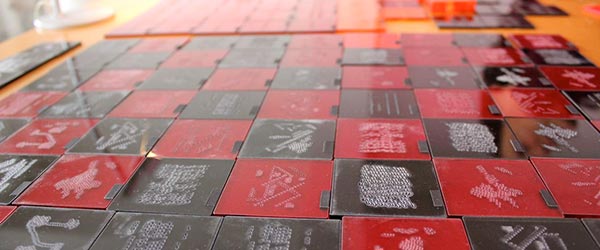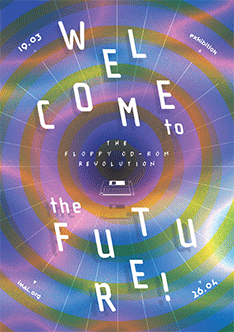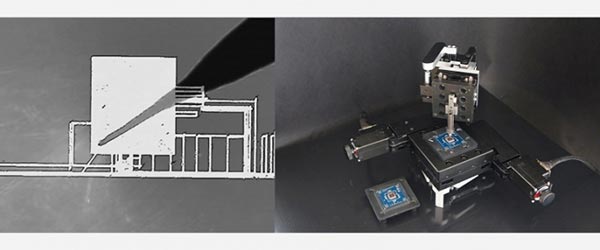In 2019, we start our Fablab Residency program! If you're an artist, designer, engineer or developer and want to develop a new creative project with our digital manufacturing machines, Fablab.iMAL can offer you a residency!
Interested? More here.

Visual artist Antoine Schmitt uses computer software as his artistic material, at the heart of creations characterised by a minimalistic aesthetic. Originally computer engineer in the fields of man-machine relationship and artificial intelligence, he contributed to the creation of numerous cd-rom, including industrial (geographical information systems), cultural or edutainment projects. He worked in particular as a freelance for Hyptique, on cd-rom like La Bande-Son, Ça Se Transforme, Au Cirque Avec Seurat et Carton de Birgé et Vitet. In 1997, he was a technical adviser for Chris Marker on his Immemory cd-rom. "Marker had almost already finished his cd-rom, I beta-tested it and sent him feedback (by fax!)".
As a developer and author, he helped with the art cd-rom Just from from Cynthia in 1996, under the artistic direction of Alberto Sorbelli, for which he created a random oracles generation and a virtual character. "We invested a space in the Centre Pompidou, in the framework of the Féminin-Masculin exhibition to set up a cd-rom production centre. All the artists would come and we worked there, in front of the audience. We were integrating media, testing, meeting. We performed numerous experiments on navigation interfaces, media integration". With the musician and sound artist Vincent Epplay, he created Infininite CD for Unlimited Music, a generative music cd-rom published in 1999.
What made you want to create an artwork on cd-rom ?
It was at the time the only medium that allowed to publish multimedia artworks (interactive, generative). The web didn't allow to run videos or execute softwares. Shockwave (that allowed to show web content created with Director) didn't exist yet, not to mention Flash. Cd-rom was the only way to reach people if you were an artist using software & multimedia as your art material.
When the cd-rom came out, did you consider it as a new storage ou a new media? Was there something like "cd-rom art"?
The new material was code (interactivity, generativity) and multimedia (several media intertwined). Cd-rom, as a publishing support of this new material, had a potential future. It was the only possible media. So there was a kind of cd-rom art. But fundamentally, it was above all multimedia & code art. It was also a new consumer product for general public contents (education, culture, general culture, encyclopaedias, etc.).
The new material was code
What was the specificity of the cd-rom for creators and artists? What new opportunities did it offer?
The cd-rom, thanks to the computer on which it ran, allowed for the creative use of programming and multimedia. A completely new field in art history.
Its limitations were only technical (video throughput, storage capacity, slow access time). Limitations which nourished a specialized craftsmanship, and without any impact on the specificity of this new form of creation, i.e. the intimate links between artistic materials and the programs, an active material which could express itself even on the smallest computer.
Was the cd-rom a real "revolution" or just a way to aggregate previous existing forms?
The foundations of the art that emerged with the cd-rom was already present before, especially through software like Hypercard (which I had used since 1987), or like Hyperstudio, used by Chris Marker for Immemory, or even Director (which I had already used in 1987, under the name VideoWorks), or of course with direct programming, as I did for my graphical and audio experiments already in the 70s. Note that I had already worked on cd-rom, educational and utilities, since 1989, within the Act Informatique company in Paris.
The cd-rom revolution, as a medium for artistic creation, came from the popularisation of this new artistic material (programming, multimedia) among a population of creative people coming from other fields of art (video, music, literature, etc..) which discovered there a new form of expression. The case of Laurie Anderson is symptomatic. Retrospectively, I think that the role of publishers has been central. It is them who solicited the creators to propose them this new platform of creation. There was money, invested (in creations) and earned (through sales and subsidies).
There was indeed convergence of existing art forms (video, photography, music, literature), but also exploration of new forms of art allowed by programming (interactivity, generativity) and multimedia (intimate links between materials coming from different forms of art: music, image, text). Which also allowed the emergence of new artists who started to explore this material.
The role of publishers has been central. It is them who solicited the creators to propose them this new platform of creation
What cd-rom made you want to create your own? Which one made the strongest impression on you? Which one do you find the most innovating/surprising?
I remember having been very touched and impressed at that time by Puppet Motel of Laurie Anderson (1995), and by the Doors of Perception of Mediamatic (1995). These two discs were full of experimentations. It was very creative, very inventive. With the floppies of John Maeda (Reactive Square and Flying Letters), these are the cd-roms that made me realise that the material that I had used forever for all sorts of experimentations (video games, artificial intelligence, etc..) could become my fundamental material as an artist. There was an emulation. I said to myself that I could do better, more personal, more precise. From there Le Pixel Blanc (1996) was born...
Was the question of technical obsolescence a concern back then?
No, we did not think too much about it.
How do you analyse afterwards the "failure" of the medium after the mid-90s cd-roms frenzy?
The arrival of internet, which gave access (and moreover, for free), to creations using this same material (programming, multimedia). As soon as Shockwave arrived, I switched to this medium.
What is the legacy of those experiments for the contemporary creation and for the digital edition?
There has been several layers of art history which have accumulated above these. Net art, and multimedia and interactive art in the late 90s. Then software art at the beginning of the years 2000. Then hacking, interactive and generative installations in the middle of the years 2000. Today the fablabs and reflections on social networks and big data. With permanent regresses (like the so-called "post-internet art" today which uses the same critical detournements of codes as net art did in the 90s).
But I think that the experimentations of the first cd-roms had opened a questioning on the active relationships between humans and their environment in general, in the sense that all of a sudden the interactive environment was the main material modelled by the artists and manipulated by the users (and in this sense the cd-rom Doors of Perception was the most precise) and that the experimentations of that time have largely not exhausted this questioning, maybe the only one to be in the realm of aesthetics (sensation) and of philosophy (metaphysics), and not in the field of social critique. It will come back. It will even probably be the only one that will remain...
The experimentations of the first cd-roms had opened a questioning on the active relationships between humans and their environment in general
Do you think it is important to preserve those early « born digital contents »? And if so, under what form?
Of course! These works of art must be visible, available for viewing. They are fundamental for art history. Any student or artist wishing to do art with computer technology should have viewed them before.
About the form, I have no preference. What is important for me: that the aesthetics is preserved, in the wide sense, that is, for most of my artworks, especially the dynamics of the artwork, the algorithm, the interactivity, the shapes, the visual composition, the colours.
The simplest in the long term is clearly the emulation of the general context necessary to the functioning of the work (which in my case is almost always a running program): operating systems, libraries (Quicktime, etc...), hardware. On a computer or online, it does not matter, but as I am reluctant to the notion of cloud, I prefer offline. Which makes also sense for collectors (individual or institution), who surely want to keep the possession of the object-artwork, and not have it on internet. If emulation is not possible, an option can be the recoding, starting from the original code. If this is really not possible, then video, paper, word-of-mouth, etc..
Interview by Marie Lechner, journalist specialised in digital cultures, and researcher at Pamal (Preservation-Archeology-Media art Lab) at the École Supérieure d'Art in Avignon (pamal.org)

A historical selection of art & culture cd-roms and electronic artworks published on floppies, mostly produced in the 90s highlighting the short life of born-digital art. It presents early pioneering works in new media and digital arts, conveying many visions and utopias around the upcoming digital world as well as remarkable explorations of interactive digital media.
WELCOME TO THE FUTURE
- Visions, Utopias & Politics
- New Art Forms
- Documenting Contemporary Art
- Digital Heritage
- All interviews
In 2019, we start our Fablab Residency program! If you're an artist, designer, engineer or developer and want to develop a new creative project with our digital manufacturing machines, Fablab.iMAL can offer you a residency!
Interested? More here.

In the context of Transmediale festival in Berlin, Wallonia Brussels International organises an exhibition showing pieces by 3 Brussels-based artists: Felix Luque, Julien Maire and LAb[au].
iMAL is very happy to be associated with this event as the co-producers of Julien's new work Composite as well as Felix's installations D.W.I. and Memory Lane.

Signals:...
The time has finally come: our renovation works at 30 Quai des Charbonnages started last week! After some demolition works, we can start building up our new, 3-storey centre for thedigital art and culture, which will open autumn 2019. Follow us on instagram,...
This page is an archive of the iMAL website that operated between 2010 and 2019. It compiles activities and projects made since 1999.
For our most recent news and activities, please check our new website at https://imal.org
asbl iMAL vzw - 30 Quai des Charbonnages Koolmijnenkaai 30 - 1080 Bruxelles Brussel 1080 - 32 (0)2 410 30 93
